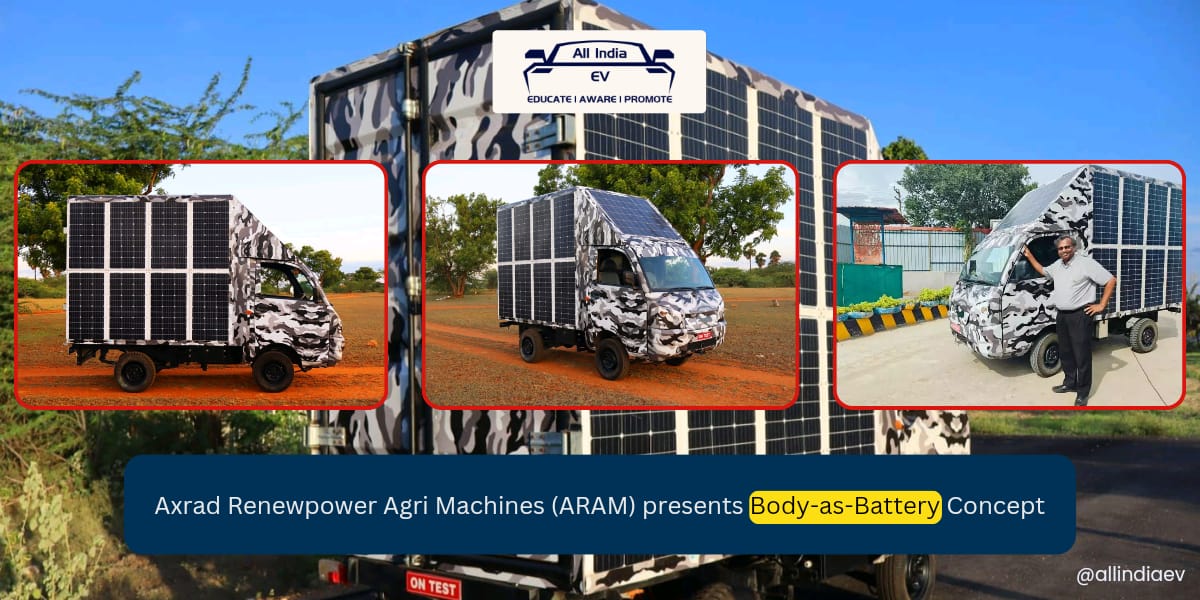
From BaaS to BaaB: A Paradigm Shift in EV Ownership
Axrad Renewpower Agri Machines (ARAM), a Coimbatore-based startup, has taken a significant step towards a greener future with the unveiling of its self-charging electric light commercial vehicle (LCV), aptly named ACV. This innovative vehicle introduces a groundbreaking concept known as “Body as a Battery (BaaB)” which integrates solar panels into the vehicle’s body to harness the power of the sun.
By incorporating solar panels into its design, the ACV can generate electricity directly, reducing the need for traditional battery charging methods. This innovative approach not only contributes to environmental sustainability but also offers practical benefits such as extended range and reduced operating costs.
The ACV’s self-charging capabilities make it a promising solution for various commercial applications, including last-mile deliveries, agricultural tasks, and urban transportation. As ARAM continues to refine and develop this technology, the ACV could pave the way for a new era of sustainable and efficient electric vehicles.
Axrad Renewpower’s ACV: powered by sodium ion battery
Axrad Renewpower Agri Machines (ARAM)’s ACV is not just another electric vehicle; it’s a testament to the innovative spirit of Indian technopreneurs. Led by Bala Pachyappa, a pioneer in the Indian EV industry, the ACV introduces a groundbreaking concept: Body as a Battery (BaaB).
At the heart of the ACV is a high-performance sodium-ion battery with a 72V/200Ah capacity and a 5C continuous discharge rate. This battery pack enables the ACV to achieve a range of 120 km on a single charge.
But what truly sets the ACV apart is its ability to harness solar power. By integrating solar panels into the vehicle’s body, the ACV can generate up to 9kWh of energy in just 6 hours of sunlight, meeting over 50% of its daily energy needs. This innovative approach not only reduces reliance on traditional charging infrastructure but also extends the vehicle’s range and minimizes operating costs.
The ACV’s combination of advanced battery technology and solar power integration represents a significant leap forward in electric vehicle design. As ARAM continues to refine and develop this technology, the ACV could become a game-changer in the commercial electric vehicle market.
BaaB: A Solar-Powered Revolution in Electric Vehicles
Bala Pachyappa’s groundbreaking concept, “Body as a Battery” (BaaB), is set to redefine the future of electric vehicles. By integrating solar panels into the vehicle’s exterior, BaaB harnesses the power of the sun as a supplemental energy source, significantly reducing the need for frequent external charging. This innovative approach enables the vehicle to generate between 41% and 62% of its daily energy requirements from sunlight, resulting in substantial operational cost savings.
ARAM, the company behind the BaaB concept, has ambitious plans for the future. The startup is targeting mid-2025 for homologation, a crucial step in obtaining regulatory approval for the ACV. Following homologation, ARAM plans to release the ACV to pilot customers by the fourth quarter of 2025.
To support the commercialization of the ACV, ARAM is actively engaged in discussions with suppliers to secure long-term agreements for critical components. The company is also focused on in-house production of key components, including sodium batteries and the solar-panel-integrated body.
Bala Pachyappa and his team at ARAM are not only pushing the boundaries of electric vehicle technology but are also addressing two of the most significant challenges facing EV adoption: charging infrastructure and operational costs. With the BaaB concept, ARAM is paving the way for a new era of sustainable and efficient electric commercial vehicles.
Solar Powering the Future: The ACV’s Sustainable Advantage
Axrad Renewpower Agri Machines’ ACV is a groundbreaking electric light commercial vehicle that harnesses the power of the sun to maximize efficiency and reduce operating costs. The ACV’s innovative solar panel system, integrated into both the top and sides of the load container, contributes significantly to the vehicle’s energy needs, covering up to 60.76% of daily requirements.
This solar integration not only reduces charging times but also extends the vehicle’s overall range and lifespan by reducing the load on the battery. The ACV’s sustainable design offers a compelling alternative to traditional internal combustion engine (ICE) LCVs.
In terms of operating costs, the ACV outperforms its competitors. Compared to conventional ICE LCVs like the Tata Ace, the ACV offers a significantly lower operating cost of INR 0.40/km, compared to INR 1.23/km for other electric LCVs and a staggering INR 5.15/km for ICE models. This translates to substantial annual savings of INR 1.75 lakh per vehicle for businesses that operate daily routes of 120 km.









